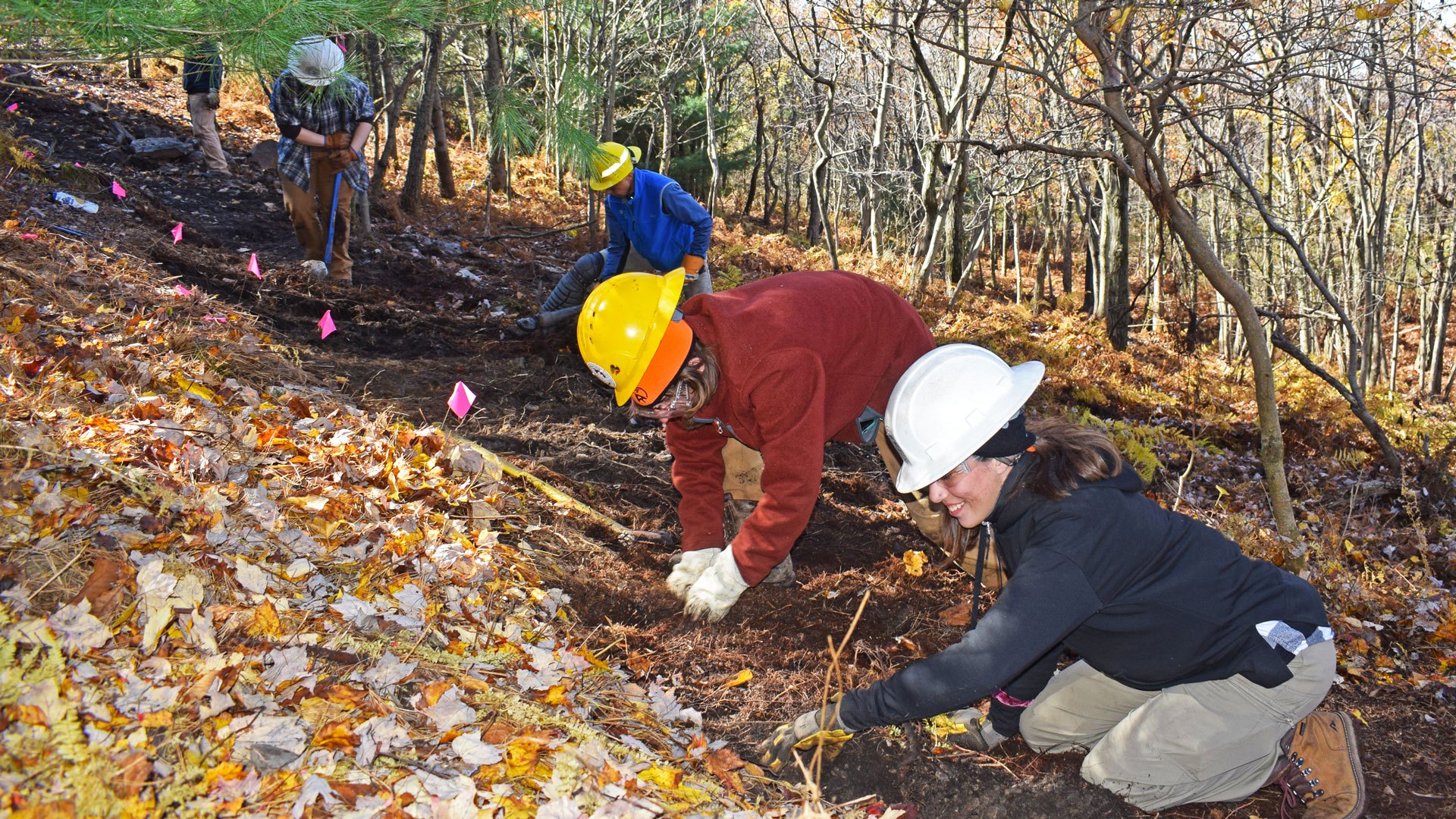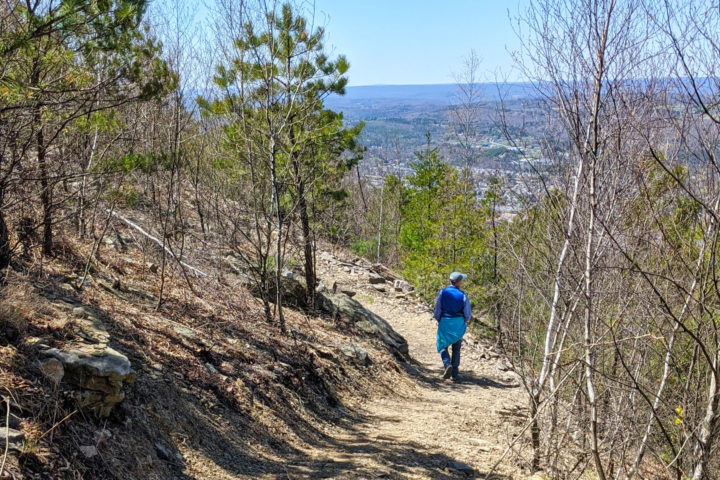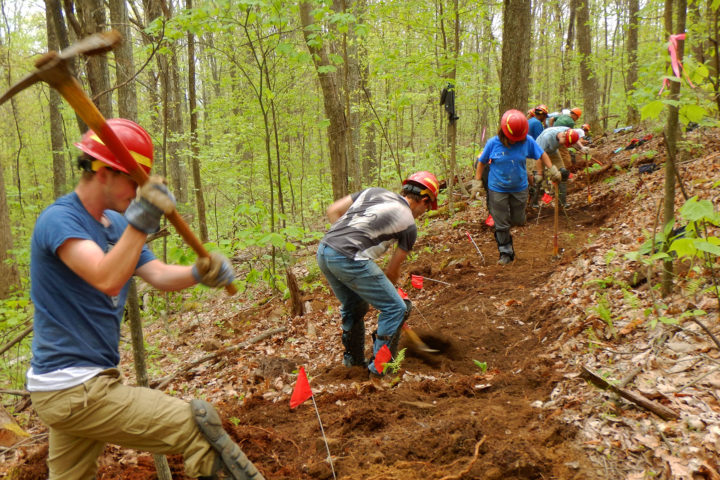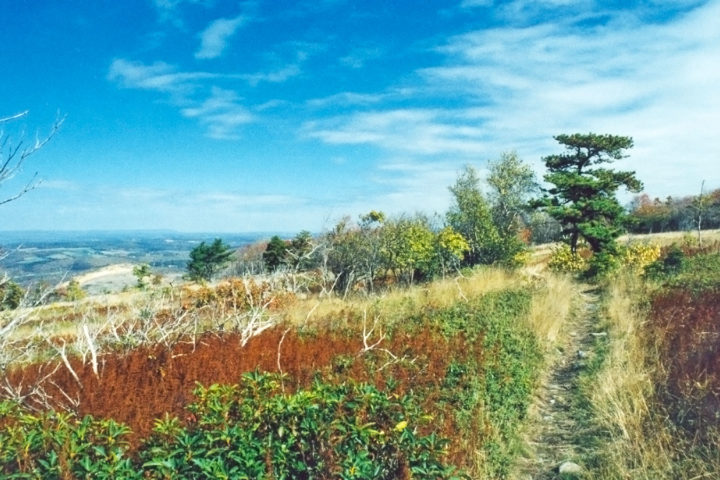By Simon Heinberg, ATC Philanthropy Manager
Inspiring a New Generation of Trail Maintainers
January 27, 2023
Along the wind-swept ridgeline overlooking Palmerton, Pennsylvania, a group of six volunteers spent eight weeks this past autumn building a new section of the Appalachian Trail (A.T.). The Trail, snaking along the Appalachian Mountains for nearly 2,200 miles, is surprisingly not a static entity — its location shifts slightly year-to-year as new land is conserved and opportunities to move the Trail to a more sustainable location arise.
Near Palmerton, the Trail once skirted around the legacy of the town’s zinc-smelting industry, a plot of forest polluted by the byproducts of a zinc smelter located hundreds of feet below in the valley. After a decades-long restoration effort initiated by the Environmental Protection Agency’s Superfund program, this once-barren plot of land is being reforested and will be the new site of the A.T.
Under the leadership of the Appalachian Trail Conservancy (ATC), a crew of twenty-somethings from around the country joined together at this unique site to relocate the A.T. and allow hikers to experience it first-hand. This enthusiastic crew was convened by the American Conservation Experience (ACE), a national leader in recruiting and training conservation volunteers to undertake environmental restoration projects on U.S. public lands. The ATC partnered with ACE, thanks to support from the National Park Foundation, to host this volunteer youth crew and provide the guidance and training needed for a successful project.

American Conservation Experience participants work on the A.T. relocation near Palmerton, Pennsylvania.
In October 2022, I had the opportunity to join the crew for a first-hand look at their hard work. I spent the day getting to know the participants, learning their stories, and taking photos of their progress. As they cleared vegetation, leveled and set stones, installed grade dips, and defined the tread of the footpath, I had a chance to learn what inspired this diverse group of young people to give back to the A.T.
An Enthusiasm for the Great Outdoors
I met up with the crew at their worksite nestled on the top of a private dirt road and surrounded by State Game Lands. I was met by their crew leader, Donovan Sheehan, who had spent much of the last year traveling with crews organized by ACE, working on a variety of conservation projects across the country. He led a crew of five, some of whom had experienced their first steps on the A.T. at the beginning of this project.
Each member of the crew had their own unique story that led them to the Trail, but they all shared a passion for conservation and the outdoors. After their time on the crew ended, many planned to continue working in environmental conservation — to them, the comforts of working 9-5 in an office were far outweighed by the adventure, excitement, and inspiration of supporting on-the-ground conservation work.

“I get to travel, be outside, and do meaningful work with amazing people… it’s genuinely changed my life.”
Bridging the Gap
Several of the crew members were in various stages of college, either taking a gap year or becoming a recent graduate. One crew member, Charles Mara, joined the crew through a connection with his alma mater, Northeastern University. Another, Sav Dopkins, graduated college in the spring with a degree in wildlife and fisheries biology. For Sav, joining the crew was an opportunity to gain outdoor work experience before continuing to either a graduate program or a job in conservation.
Other crew members had recently left the workforce, quitting jobs to travel the country volunteering with the ACE crew. Michael Bass joined the crew seeking change, as he had grown tired of his job as a waiter. He explained how his work on the crew building trail allowed him to work toward a larger goal, and it came with the satisfaction of seeing literal progress being made every day. He described his time on the crew as the most rewarding work he had ever done.
“I get to travel, be outside, and do meaningful work with amazing people,” he said. “It’s such a unique experience; it’s genuinely changed my life.”

Despite the effort and sweat spent throughout this project, any obstacles and challenges only seemed to increase the crew’s motivation and enthusiasm.
Creating Community in Nature
While the crew members all came from different backgrounds and parts of the country, they functioned together like a family. For eight weeks they lived and worked together, taking turns cooking meals and building towards a common goal: constructing an entirely new section of the A.T. Their enthusiasm and comradery were palpable, and they were constantly laughing and chatting as they completed the construction of this new section of Trail, inch by painstaking inch.
 Despite the effort and sweat spent throughout this project, any obstacles and challenges only seemed to increase their motivation and enthusiasm. One of their favorite experiences so far was spending over an hour removing a boulder heavy enough to bend their tools. Rather than fret at the weight of this stone, they saw the challenge as an opportunity for teamwork — a less hardy group might instead approach the task with frustration and exhaustion.
Despite the effort and sweat spent throughout this project, any obstacles and challenges only seemed to increase their motivation and enthusiasm. One of their favorite experiences so far was spending over an hour removing a boulder heavy enough to bend their tools. Rather than fret at the weight of this stone, they saw the challenge as an opportunity for teamwork — a less hardy group might instead approach the task with frustration and exhaustion.
The crew’s positivity, inspiration, and motivation to continue this painstaking (yet rewarding) conservation work are what I will remember the most from the time we spent together. Those feelings may also be the greatest legacy of the crew experience for the participants — perhaps even more than the footpath they built through the rocky Pennsylvania landscape. Thanks to the opportunity provided by the American Conservation Experience and supported by the ATC, this group of five young people learned what it takes to be the next generation of conservationists and outdoor leaders who protect the public lands we all cherish.
Volunteering for the Appalachian Trail is one of the most fulfilling ways to help conserve this national treasure. Find your own opportunity today.
Discover More

ATC News - June 16, 2022
A.T. Reroute Opens in Palmerton, Pennsylvania
This 3.25-mile-long relocation moves the route of the A.T. along views that are likely to remain as important environmental remediation work in the area continues.

Official Blog
The Scope of A.T. Volunteerism
For almost 100 years, volunteerism has been the bedrock of the Appalachian Trail and the ATC.

Official Blog
A New Path for the A.T. in Palmerton
As life returns to the hills above Palmerton, Pennsylvania, the ATC is working to enhance the A.T. experience for future Trail users.





